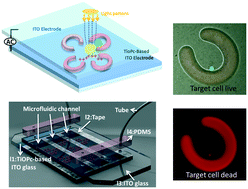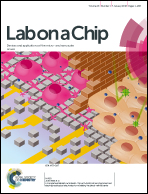Cancer immunotherapy μ-environment LabChip: taking advantage of optoelectronic tweezers†
Abstract
A cancer immunotherapy μ-environment LabChip, equipped with titanium oxide phthalocyanine (TiOPc)-based optoelectronic tweezers (OET) to achieve direct cell–cell contact, can be used to study the interaction between immune cells and other cells for real-time analysis of NK cells' behavior. In microfluidic devices, it is difficult to solve dead zone problems and observe dynamic cell–cell interactions. We have created a stable and static culture μ-environment which can enhance NK cell activities. In addition, OET is used to solve dead zone problems by manipulating a single cell into four-leaf-clover-shaped (FLCS) microwells made of poly(ethylene glycol) diacrylate (PEG-DA) through optofluidic maskless lithography, causing direct cell–cell contact. Our design reconstructed an in vitro human immune system for the study of dynamic immunological response. When the NK cells came into contact with the target cells in the μ-environment LabChip, we observed that the target cells showed apoptotic characteristics (i.e. cell shrinkage and blebbing within 2 h and then die within 3 h). In addition, our μ-environment LabChip demonstrated higher NK cell activity compared with conventional analysis. We have created an innovative cancer immunotherapy μ-environment LabChip to provide a stable and static μ-environment for cell–cell interaction study. Furthermore, our μ-environment LabChip showed the potential to enhance NK cell activity and to study immunological interactions between immune cells and cancer cells dynamically.

- This article is part of the themed collection: Immunotherapy


 Please wait while we load your content...
Please wait while we load your content...